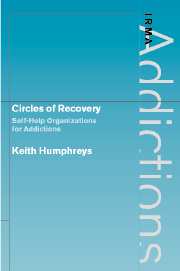Book contents
- Frontmatter
- Contents
- Acknowledgements
- 1 Definitions, scope, and origin of the health-related self-help group movement
- 2 An international tour of addiction-related mutual-help organizations
- 3 Does self-help group participation lead to positive addiction-related, psychiatric, and medical outcomes?
- 4 A different perspective on change in self-help organizations: spirituality, identity, life stories, friendship networks, and politicization
- 5 How should government agencies, healthcare organization, and clinicians interact with self-help organizations?
- Epilogue: summing up, moving forward
- References
- Index
- References
References
Published online by Cambridge University Press: 31 July 2009
- Frontmatter
- Contents
- Acknowledgements
- 1 Definitions, scope, and origin of the health-related self-help group movement
- 2 An international tour of addiction-related mutual-help organizations
- 3 Does self-help group participation lead to positive addiction-related, psychiatric, and medical outcomes?
- 4 A different perspective on change in self-help organizations: spirituality, identity, life stories, friendship networks, and politicization
- 5 How should government agencies, healthcare organization, and clinicians interact with self-help organizations?
- Epilogue: summing up, moving forward
- References
- Index
- References
- Type
- Chapter
- Information
- Circles of RecoverySelf-Help Organizations for Addictions, pp. 182 - 218Publisher: Cambridge University PressPrint publication year: 2003



